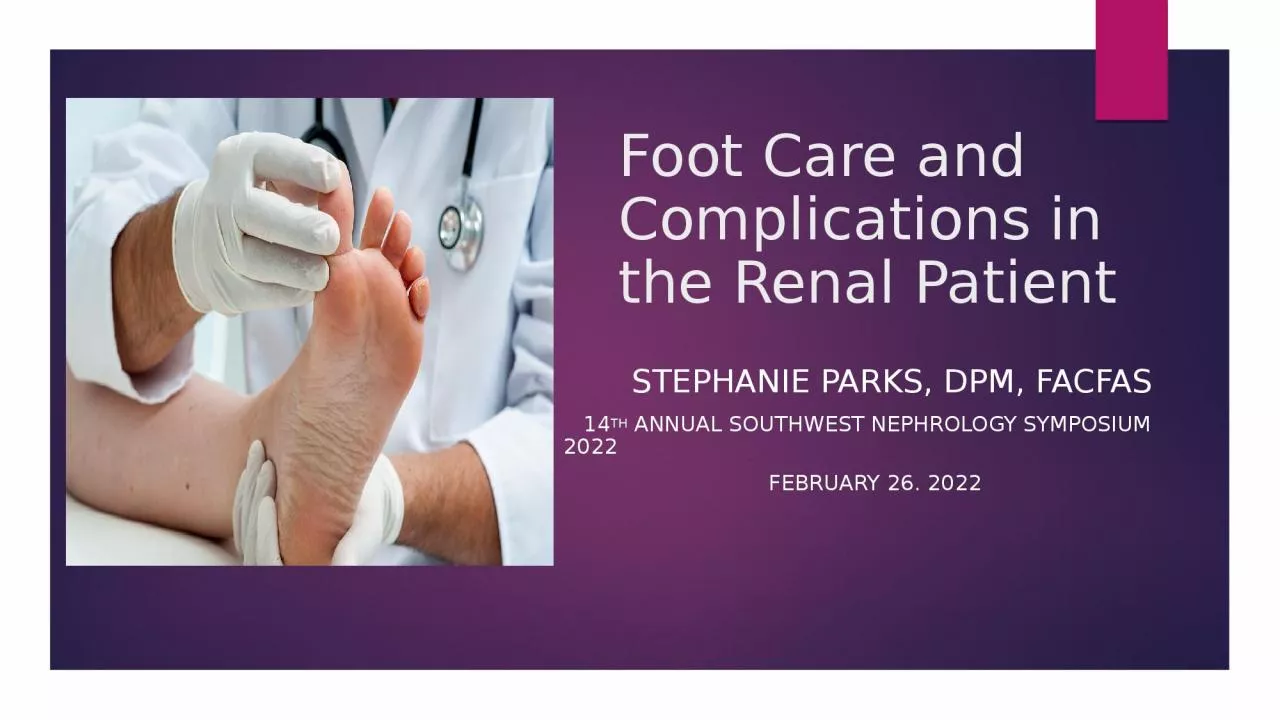

Stephanie Parks DPM FACFAS 14 th Annual Southwest Nephrology Symposium 2022 February 26 2022 Stephanie Parks DPM FACFAS Conflicts of Interest I have no conflicts to disclose ID: 1036030
Download Presentation The PPT/PDF document "Foot Care and Complications in the Renal..." is the property of its rightful owner. Permission is granted to download and print the materials on this web site for personal, non-commercial use only, and to display it on your personal computer provided you do not modify the materials and that you retain all copyright notices contained in the materials. By downloading content from our website, you accept the terms of this agreement.
1. Foot Care and Complications in the Renal Patient Stephanie Parks, DPM, FACFAS 14th Annual Southwest Nephrology Symposium 2022 February 26. 2022
2. Stephanie Parks, DPM, FACFAS
3. Conflicts of InterestI have no conflicts to disclose
4. OverviewDiabetic Foot DiseaseRisk factors for pedal complications in renal patientsPeripheral NeuropathyVascular diseaseUlcerationsCharcot neuroarthropatyInfections
5. Diabetic Foot Disease
6. Risk Factors for Foot Disease in Renal PatientsPeripheral NeuropathyVascular DiseaseSusceptibility to infectionDialysisReduced ability for self careAnemia
7. Peripheral Neuropathy
8. Peripheral Neuropathy - MotorLeads to denervation of the muscles of the leg and footGait alterationsPoor balanceLack of proprioceptionFoot deformitiesMuscle wastingClaw and hammertoe deformitiesIncreased forefoot pressures
9. Peripheral Neuropathy - SensoryCharacterized by demyelination and axonal degenerationNumbness, tingling, burning, or all Major risk for developing ulcerations and infection
10. Vascular DiseaseProcalcific state increase in CKD/dialysis patientsIncrease in vascular calcifications leading to decreased flow to the extremitiesSlower healing wounds
11. Increase Susceptibility to Infection in Renal Patients
12. Diabetic Foot Disease in Relation to the Degree of Renal ImpairmentCKD not requiring dialysisRisk of diabetic foot disease increases as renal function decreasesGFR >60 – risk is similar to non CKDGFR 30-60 – 1.85 x normal for diabetic foot ulcers, 2.08 for amputationGFR <30 – 3.92 x normal, 7.71 for amputation
13. Diabetic Foot Disease in Dialysis
14. Foot UlcerationsMajor cause of morbidity and mortalityNeuropathy is the primary causeDelayed healing is multifactorial, heavily associated with vascular diseaseESRD is an independent predictor of nonhealingHigher prevalence of PVD in ESRD patients
15. Foot UlcerationsIdentification is key to prevent complicationsControlling friction, abrasion, deformities, trauma
16. Venous, Pressure, and Arterial UlcerationsMany issues may be superimposed and require a multidisciplinary team to treatBegin with Noninvasive studies Arterial and venous duplezAny renal pt with a woun or DM should have at least arterial studies annually for survalenceRefer to vascular specialists ASAP to establish baseline
17.
18. Ulcer PreventionControl of risk factorsWell fitted, supportive shoesInsurance will cover 1 pair of diabetic shoes with 3 sets of friction reducing insoles per yearCompliance with shoe year, insoles, and specialist appointmentsDaily inspection of feet, shoesHave a family member helpHold a mirror to feet (attach to broom stick if needed)“But doc, I only wore these because I was coming here, normally I wear really good shoes”
19. Why are Ulcers Difficult to Heal?Compliance ComorbiditiesLack of understanding from the patients standpointIts important to reiterate that just because this problem is new does not mean that it will resolveFrank discussions need to be had regarding the risk factors and statistics, preferably with handouts given“I’ve always been a fast healer”“I’ve been wearing these shoes forever, it couldn’t be them”“I only use shoes at home”“I’ve been applying a “salve” to it“ I can’t take off work”“my grandparents healed with this XYZ”“I’ve been smoking forever and have not had problems until now”
20. Charcot NeuroarthropathyRare but serious condition of the bones and joint, primarily of the foot and ankleTwo hypothesis on the developmentIncreased blood flow decreasing bone densityMicrotrauma leasing to degenerationRegardless of cause, often precipitated by a known or unknow trauma
21. CharcotBegins as a red, hot, swollen footMimics infectionMRI will read positive for osteomyelitisBone biopsy is the only definite way to diagnoseSTRICT, 100% NONWEIGHTBEARING UNTIL CONCOLIDATION OCCURS (MONTHS)Bones begin to fragmentCoalescence occursRemodelingStabilization occursDeformity will require either bracing or surgery and is often not amenable to limb salvage
22. Charcot FootTypical rocker bottom foot deformity
23. CharcotAcute Charcot ankle, PreopCharcot post reconstruction
24. Preventative careOne of the most powerful tools in preventing pedal complications in renal and diabetic patientsRegular inspection of feet and shoes by all providers as well as patientPalpate/doppler pulsesAsses sensationTest motorPerform a gait assesmentDialysis staff catch a large amount of pedal issues
25. Importance of a Multidisciplinary Team ApproachRenal disease and diabetes can be an intimidating diagnosisPatients are best served by a multidisciplinary teamNephrologyDialysis care teamEndocrinologyPrimary CarePodiatryVascular/cardiology
26. How often should a patient see a podiatrist?
27. Referenceshttps://www.ncbi.nlm.nih.gov/pmc/articles/PMC4254470/https://www.ncbi.nlm.nih.gov/pmc/articles/PMC4200295/https://onlinelibrary.wiley.com/doi/10.1111/j.1755-6686.2012.00284.xhttps://bmcnephrol.biomedcentral.com/articles/10.1186/s12882-019-1594-5https://www.sciencedirect.com/science/article/abs/pii/S1553838919305925https://onlinelibrary.wiley.com/doi/10.1111/j.1755-6686.2012.00284.xhttps://www.sciencedirect.com/science/article/pii/S2468024921016089https://diabetesjournals.org/care/article/31/7/1331/39039/Association-Between-Renal-Failure-and-Foot-Ulcerhttps://iwgdfguidelines.org/introductionhttps://www.ncbi.nlm.nih.gov/pmc/articles/PMC4200295/https://www.ncbi.nlm.nih.gov/pmc/articles/PMC4254470/https://www.tandfonline.com/doi/full/10.1080/08860220701391662
28. Referenceshttps://www.researchgate.net/figure/The-non-wounded-diabetic-foot-Patients-with-diabetes-may-develop-thick-calluses-on-their_fig2_327799981https://www.semanticscholar.org/paper/Diabetic-neuropathy-and-foot-complications.-Boulton/fbda9a667898e3b2b379fc462c17baf788074a4f/figure/3https://www.researchgate.net/figure/Left-foot-photograph-of-a-patient-with-autonomic-neuropathy-and-a-plantar-diabetic-foot_fig3_326817134https://patientengagementhit.com/news/how-to-use-team-based-care-to-improve-the-patient-experiencehttps://www.pinterest.com/pin/10836855335318476/https://www.sutherlandpodiatry.com.au/conditions/peripheral-vascular-disease/https://insightsimaging.springeropen.com/articles/10.1186/s13244-019-0768-9